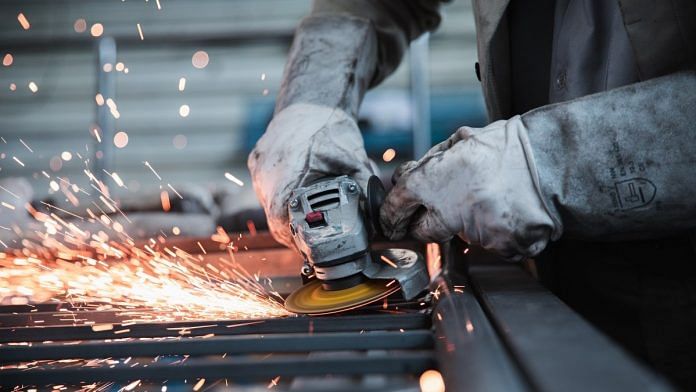Steel production is the planet’s largest-emitting manufacturing sector, responsible for 7% of all man-made greenhouse gas emissions. This is because it relies on high-carbon coal in its production process. Yet, steel may be one of the best candidates to lead global decarbonization efforts.
Strong post-pandemic demand for steel and government policies supporting more low-carbon production is creating a situation ripe for steelmakers willing to commit the necessary resources to decarbonize. The industry, however, is unlikely to make this transformation to low-carbon steel on its own. The key to commercial-scale green steel — steel made without using fossil fuels — lies in cross-industry partnerships.
Based on our calculations, capital expenditures (CAPEX) of anywhere between €2 trillion and €3 trillion will ultimately be required to build the capacity necessary to push green steel to the forefront. And, despite its enormity, this investment would only cover the conversion of iron and steel capacity and not the construction of the necessary green energy sources to power the production. That will take trillions more.
In search of steel partners
It is unlikely that any steel producer or even the entire industry en masse could supply that magnitude of CAPEX between now and 2050. But steel can pool resources through partnerships, joint ventures and alliances with companies in sectors that will also benefit from steel’s conversion.
These could be industries involved in steel production, such as upstream suppliers from energy, mining, chemicals and private capital. Or a partner could come from downstream, from among the many industrial end users reliant on steel, such as automotive, transportation and construction companies.
Steel is a building block of the global economy. It is used by almost every industry to some extent. Its pivotal role, combined with the increasingly pressing need to decarbonize, makes the creation of these kinds of investment ecosystems not only likely but logical. And, it’s one of the reasons why steel should be at the head of the line for decarbonization.
Why start with steel?
Two billion or so metric tons of crude steel are produced globally every year. If all that tonnage were green steel instead of carbon-intensive steel, it would dramatically cut the emissions of the steel industry, and it would also reduce hefty portions of the carbon footprints of the automotive, construction, transportation, energy and manufacturing industries, to name the most notable.
For instance, the average vehicle is more than 50% steel, which makes steel responsible for the majority of a vehicle’s carbon footprint. Thus, a switch to green steel would automatically reduce the automakers’ emissions profile significantly.
The other major reason steel makes such a good candidate for decarbonization is the maturity of most of the technology used in the transition. Take electric arc furnaces, which would ultimately replace the blast furnaces steel has relied on for over a century. They will be used to produce green steel, but they are already used today to make about 29% of conventional steel.
The difference between current production and a green steel future: today’s electric arc furnaces run on conventional energy powered by a mixture of sources, including natural gas and coal. In a green steel future, they would be powered by only renewable energy, which could be provided by hydro, nuclear, wind or solar energy or a combination. All these technologies exist, which is a big advantage for steel.

Not enough renewable energy
The one new element expected to be prominent in green steel production is the use of green hydrogen in the direct reduction of iron. Creating that hydrogen capacity, however, will involve additional sizable capital investment.
But, the global economy faces a bigger problem. There isn’t a sufficient supply of renewable energy to produce enough green hydrogen at a competitive cost for commercial-scale green steel production, let alone decarbonize power generation. The additions needed in wind and solar alone would be four times the size of the record level of expansion in 2020 and require, in the International Energy Agency’s words, “a period of unprecedented clean energy investment.”
For this reason, companies that intend to lead the steel industry down the decarbonization path should consider bringing energy producers into their ecosystems to help build sufficient green power. The two standout pioneers in green steel — H2 Green Steel in Sweden and Boston Metal in the United States — did just that.
In 2022, Hitachi Energy invested in H2 Green Steel and Finnish power company Fortum signed an agreement to supply H2 Green Steel with carbon-free electricity generated primarily from hydro and nuclear power. Boston Metal, on the other hand, is building its first full-scale green steel facility in Brazil, the second largest producer of hydropower by installed capacity.
Besides energy, these pioneers have also joined forces with one of the industries set to benefit from its success — automotive manufacturers. H2 Green Steel has partnered with Mercedes Benz and Boston Metal got an investment from BMW. The advantage for sizable end users, such as automakers, is the ability to guarantee a supply source of green steel through pre-arranged supply deals. This will be important, especially in the early days when green steel will be in short supply.
Both green steel startups also received sizable investments from some of the world’s largest steelmakers: ArcelorMittal invested in Boston Steel and Kobe Steel in H2 Green Steel. Mining giant BHP also invested venture capital in Boston Metal.
If the steel industry is to become a leader in decarbonization, the next seven years will be make-or-break, given how long it will take to put together the necessary ecosystems and create new capacity. But as the effects of climate change become more pronounced, the global economy needs to start applying resources efficiently to produce the biggest and fastest reduction of emissions possible, making the argument for prioritizing steel a strong one.
The article was originally published in the World Economic Forum
Also read: Data can help decarbonise cities, lead urban transformation



